Within this framework, reality consists of the domains of the real, the actual, and the empirical. The domain of the empirical relates to perceptions of experiences, while the real is concerned with events that produce these experiences.
Of representation and academic literacy
- Introduction to the research problem
- The nature of academic literacy
- Understanding social exclusion
- Objectives of the study
- Questions to be answered in the research
- Significance of the study
- Theoretical approach
- Research methodology of the study
- Philosophical stance
- Data Collection and treatment
- Classroom observations
- Interviews
- Documents
- Data analysis
- Validity
- Organisation of the thesis
How do these representations of student and academic literacy affect the context of teaching and learning. Therefore, the framework I used allowed for an examination of teaching and learning practices in the context of academic literacy.
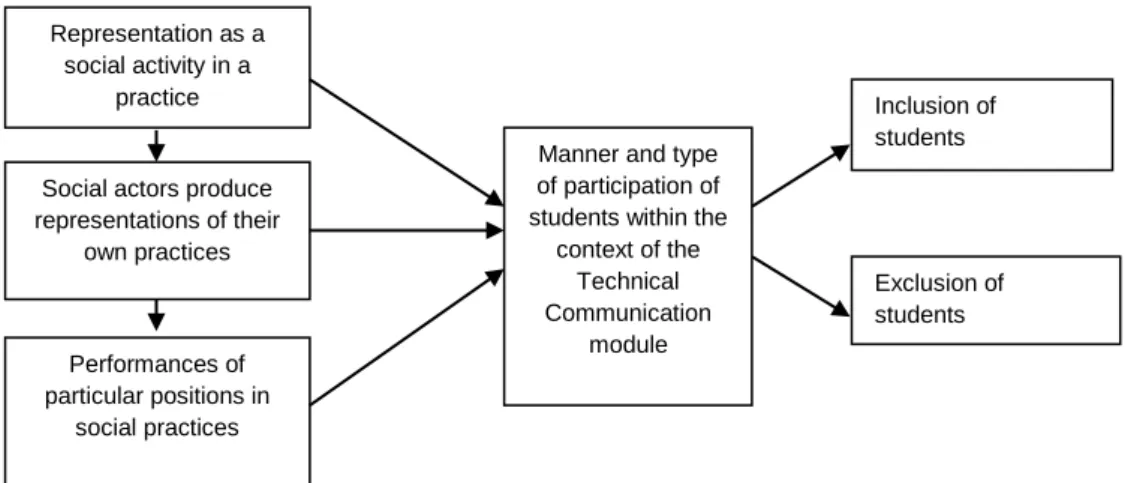
Of discourses, semiosis and representation
Introduction
Organisation of the literature
The purpose of this discussion is to show how these three concepts are intertwined and work together to achieve social inclusion and exclusion of social actors (e.g., students) in a discourse community. The discussion will also serve as a basis for the discussion in Chapter 3, which draws on the literature to show how discourses can influence representation and in turn be influenced by the same forms of representation.
The nature of discourses
- Discourse as a social practice
- Engineering as a Discourse
In contrast, engineering rhetoric has its roots in the arts (Winsor, 1996) and is considered a soft discipline (Belcher and Trowler, 2001). This understanding of the relationship between discourses, writing and academic knowledge is crucial in this study.
Introducing semiosis
- Bhaskar‘s semiotic triangle
- Pierce‘s semiotic paradigm
In other words, the immediate object refers to the perception or knowledge we have of the sign. Clearly, Pierce's distinction between dynamic and direct objects shares an affinity with Bhaskar's transitive and intransitive domains of the sign.
Semiosis and representation in general
- Semiotic aspects of social structure, practices and events
It is easy to see why semiosis is of great importance to my study, as it seeks to explore representations of students as well as of the academic literacy context and how these serve to include or exclude some students. First, semiosis is part of a social activity within a social practice, and using language (small letter discourse) is part of the academic literacy teaching and learning context.
Semiosis and the representation of engineering knowledge
The fact that technical writing is designed to divert one's attention from oneself to the subject is one of the factors that gives it power. The invisibility of the author/researcher is thus a control mechanism in the sense that it forces the reader to read the text as absolute and the knowledge presented as.
Concluding remarks
Easson and Bruce (2000 p.1) emphasize that the rationale for the structure of a technical report stems from the necessity that it can be read at different levels. In the context of academic literacy, these representations of students come from competing definitions that I discuss in Chapter 3.
Shaping influence of discourses
Introduction
Organising the literature
Alternative forms of presentation will also be available, largely derived from studies of new literacy. This aspect of the chapter draws from the dominant concepts of academic literacy discussed in Part One.
Representing literacy in higher education
In the third section, the focus will be on orientations in teaching academic literacy subjects. As my awareness of this field develops, I have found it necessary to question the relationship between this lack of consensus about the meaning of literacy and how students are represented in higher education.
Metaphors for literacy
- Scribner‘s literacy metaphors
- Barton‘s literacy metaphors
- Literacy as a social practice
Literacy as a power metaphor is used in arguments about the role of literacy in society. Through this metaphor we are made to think about the acquisition of literacy as a result of the interdependence.
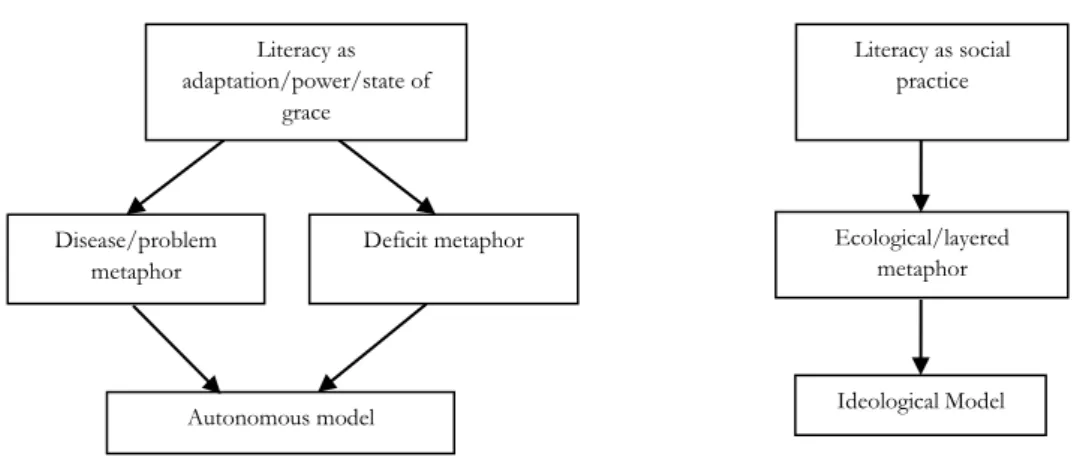
Tying together
The different semiotic representations of literacy that I have discussed above are indeed different and have very different meanings. Put in this way, literacy is always ideological, and some meanings gain prominence and dominance over others.
Representing students
In the South African context, it is clear that the dominant discourse arising from deficit conceptualizations of literacy has led to the attribution of failure to students. Practitioners must understand that as students progress in the discipline, they further approximate the conventions of the discipline.
Tying together
Shor (2001), on the other hand, uses a critical literacy approach in his critique of student representation and literacy and suggests that educational and socio-economic inequality has bred the concept of remediation. Instead of academics examining the inequalities that exist in society, they have thus concentrated on students, and the focus is on changing people/students more than the educational system in which they confront learning.
Orientations to the teaching of literacy
- The academic skills model
- The academic socialisation model
- The academic literacies approach
- The socio-political discourse/critical literacy
Therefore, the notion of voice – the author's identity, stance and ownership of the text – is privileged (Bengesai, 2010). Gonzalez (2006) is also of the opinion that the process of acculturation, which is prioritized in the academic socialization approach, hinders student agency.
Concluding remarks
The focus is now more on critical language awareness, with a focus on the rediscovery of a new South Africa (Janks, 2000). A critical language awareness program is therefore focused on designing a curriculum that lets students' voices be heard and recognizes identities.
In dialogue with, Gee, Bourdieu, Lave and Wenger and Bernstein
- Introduction
- Gee‘s identity framework
- Bourdieu
- Habitus and cultural capital
- Bernstein‘s pedagogic device
- Lave and Wenger‘s situated learning
- Key features of situated learning: Participation
- Communities of practice
- Power, difference and representation
- Relevance of theories to the South African context
- Conclusion
In this field, teachers and students also translate this knowledge into the recontextualization field of the classroom. It is the purpose of this study to bring the inner functions of the educational apparatus to the fore in connection with the course Technical communication for engineers.
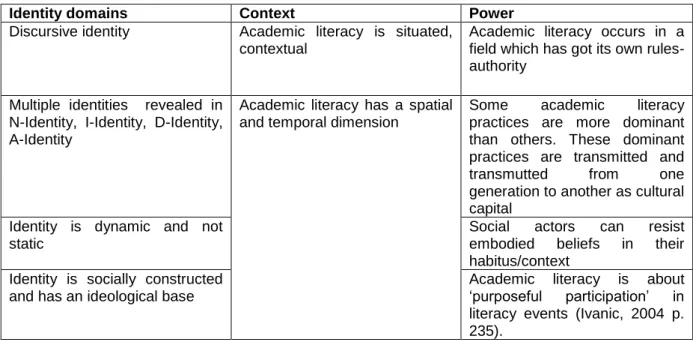
Exploring reality: a critical realist study
Introduction
This chapter therefore establishes both epistemological and ontological positions from which I am able to make sense of the data in the study. Or as Berg (2007) describes research design, this chapter describes the plan according to which the study was conducted, indicating the type of data collected, how it was collected and used, where and when it was collected, and why they were collected. was collected.
Paradigm
- Analytical framework of analysis
- Stratified reality and contingent causality/ epistemological stance
Simply put, the domain of the real produces mechanisms that produce events that manifest in empirical sensations (see Figure 5-1). This is because it provides an ontology that helps uncover the nature of the unobservable causal mechanisms that produce the practices (discursive constructions of identity) that are evident at the empirical level.

A critical realist research design
- Research objectives
- Research approach
- The research sample
The research is primarily based on the insight that knowledge of reality is discursive (Agger, 2006). To answer these questions, the study followed the approach and methodology described in the next section.
Data collection
- Data collection at the empirical level
- Data collection at the actual level
Standard knowledge was identified in course goals and task topics. I also sought students' perceptions of academic literacy and of the Technical Communication for Engineers course in particular.
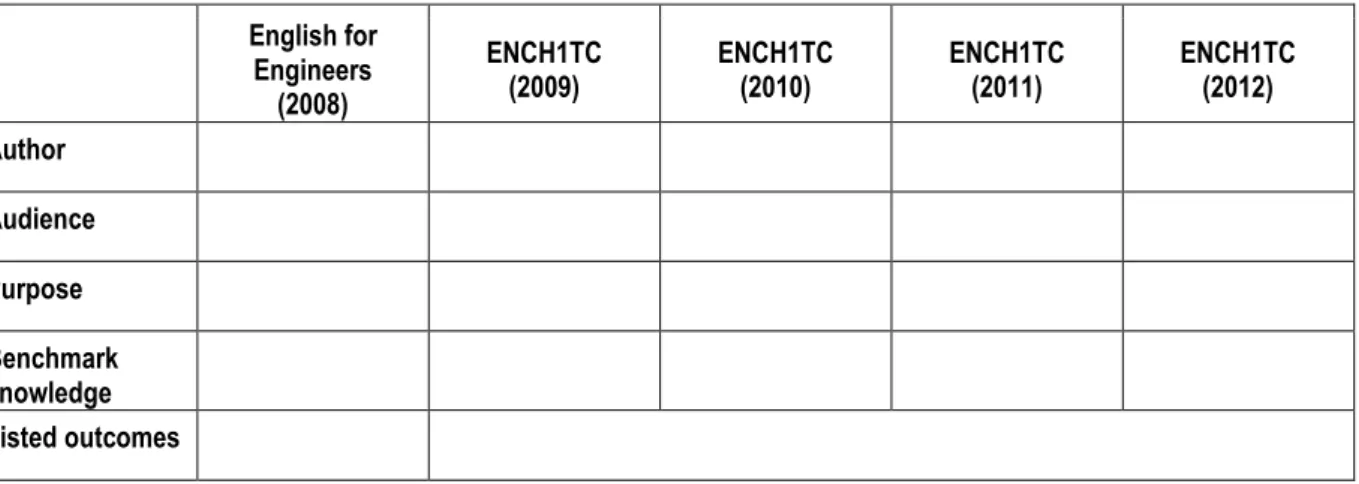
Data analysis
Based on this understanding of CDA, I coded in the analysis phase of this study for the contextualization of the reading skill. This identification required a form of semiotic interpretation of the ways of thinking and being available to the various actors in this context.
Validity
Limitations of the study
Ethical issues
Concluding remarks
Empirical Experiences of academic literacy
Introduction
The first section presents data resulting from the Faculty Handbook and the Technical Communication course packages from the first semesters from 2008 to 2012. What are the dominant discourses that frame the representation of academic literacy in a Technical Communication course in an Engineering Faculty.
History of the Technical Communication course: Documentary Evidence
- English for Engineers (2008)
The emphasis on English suggests that the course focused on providing students with a foundation in the grammatical and linguistic (technical) aspects of the English language. These assumptions about academic literacy as a set of essential and generic skills were embodied in the course materials.
Technical Communication for Engineers (ENCH1TC): 2009 to date
- Course reader: 2009 version
- Course reader: 2010 version
- Course reader: 2011 version
- Course reader: 2012 version
8 A seminar presentation in connection with the course Technical communication for engineers is a literature review. In terms of discourse, four out of these nine readings had occurrences of first-person pronouns, symbolic of textual self-representation (Hyland, 2002b).
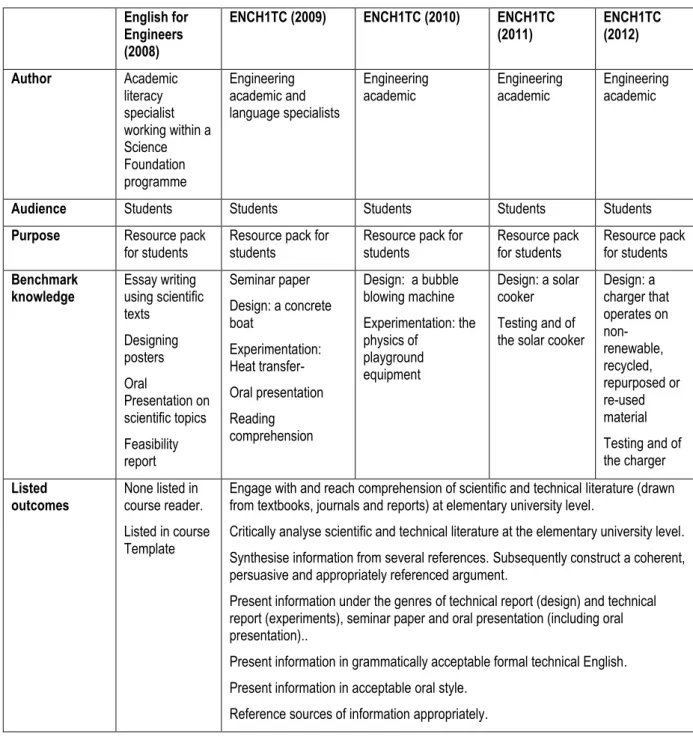
Discourse that reduces academic literacies to English language proficiency
I have already mentioned that from a critical realist perspective, a descriptive analysis represents surface appearance of the data. Another indication of the discourse that mixes technical communication with the English language is found in the objectives of the new course, Technical Communication for Engineers.
Interview data
- Tutors‘ perceptions of technical report writing
- Tutors‘ perceptions of students
- Students‘ perceptions of Technical Report Writing
- Students‘ representations of the self
- Engineering academics‘ understanding of Technical Report Writing
Students' perceptions of themselves in the context of academic literacy were also sought through interviews. In my view, these academics would and would provide an inside perspective on the place of technical report writing in the engineering curriculum.
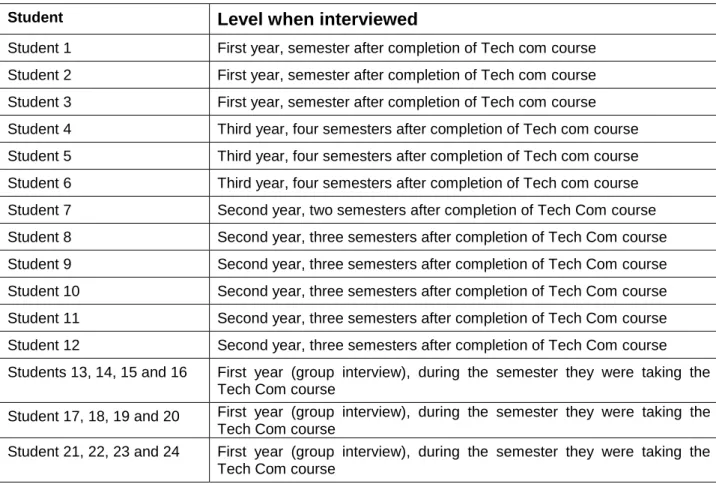
Perceptions of the Technical Communication course
- Students‘ perspectives
- Tutors‘ perceptions of the adequacy of the course
From the pedagogical side, the mentors also made various comments regarding the appropriateness of the course. For this tutor, the notion of discourse (in the sense used by Gee and adopted in this study) was the criterion for determining the appropriateness of the course.
The deficit discourse
It is clear that talk about students' "experiences in Technical Communication for Engineers takes place in a context that stereotypes differences by focusing only on black students. Drawing on the theoretical construction of participation adopted in this study, I am convinced that this way of representing learner profiles constructs English L1 learners as closer to full participation in the academy, while it constructs ESL learners as outsiders to the discourse.
Assigning the agency to learn to students
Thus, when they enter the university, they must "reinvent the university by gathering and imitating its language, finding a compromise between idiosyncrasy, a personal history, and the requirements of convention, the history of the discipline" (1985 p. 403). For me, this is the crux of the matter, and I argue, in line with McKenna (2004a), that it is difficult for students to learn a new Discourse with which they cannot identify.
Technical communication as entrée to the Engineering profession
In the following subsection I discuss the discourse linking technical communication to the engineering profession. In this way, technical communication is considered to be the ―ultimate goal of engineering literacy‖ (Simpson and van Ryneveld, 2009 p. 801).
Conclusion
Actual Experiences of the Technical Communication course for Engineering
Introduction
Overview of the chapter
How students represent themselves in technical report writing
This was followed by a closer analysis of the role of these pronouns in the students' texts. Nevertheless, the data analyzed in this study reveal a high prevalence of first-person pronouns in the students' texts.

Feedback as a form of representation
I now turn to the analysis of the written comments that the tutors gave to the students. Therefore, the use of the word ambiguous in the feedback comments in this corpus was itself ambiguous.
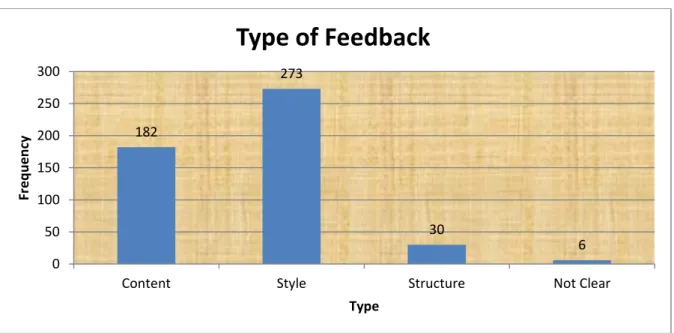
Classroom observations
- The lectures
- The tutorials
Unfortunately for these tutors, their only involvement in the course was to run the exercises. Returning to the classroom discourse excerpts above, it is evident that the tutors acknowledge the students' expertise on the technical aspects of the course while foregrounding their own expertise on language issues.
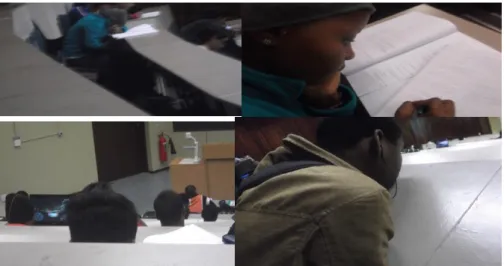
Conclusion
Real experiences of academic literacy in a Technical Communication course
Introduction
Organisation of the Chapter
Design as participation in a discourse
What are students excluded from?
- Exclusion from epistemological access
- Packaging of academic literacy into a course as an exclusionary pathway
Tutors: outsiders looking in
Concluding remarks
Conclusion
Introduction
Revisiting the research problem
Methodological Considerations
Representation of academic literacy/Technical Communication
- Representation of students
Representations of self
Conclusions of the study
Future Directions
Concluding remarks
Tutorial 4



